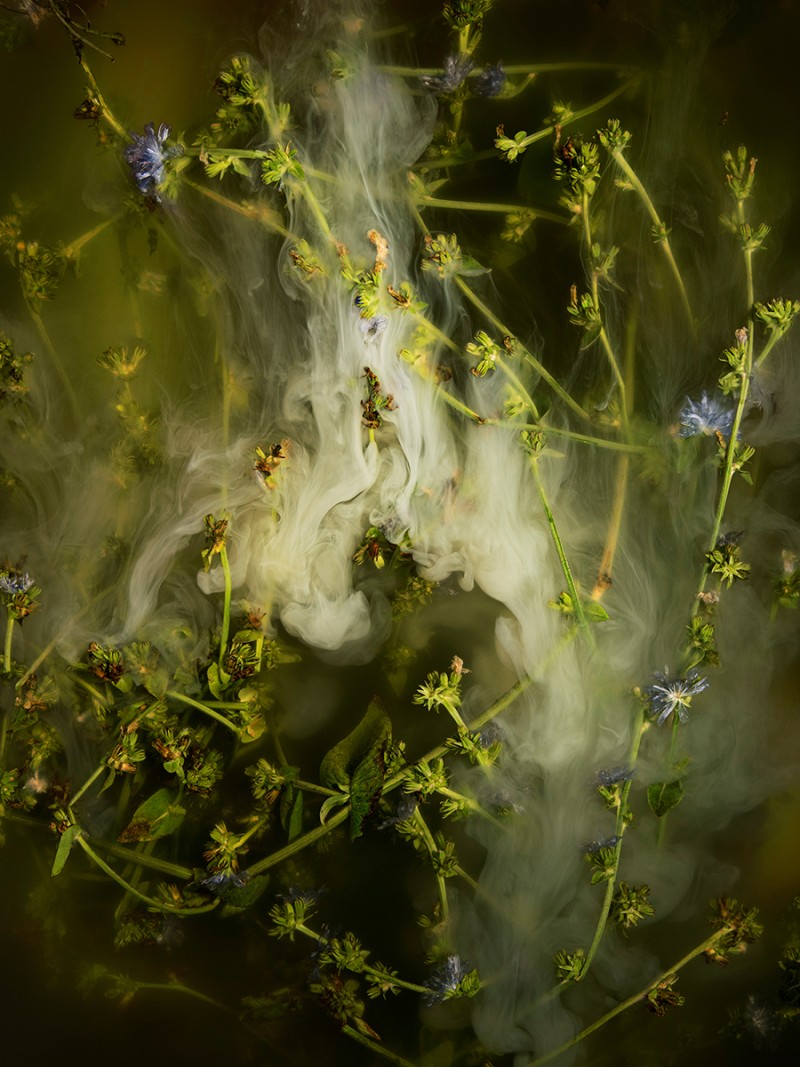
All the blue flowers follow the sun (chicory, succory, blue sailors, coffeeweed, wild Succory, blue daisy, blue dandelion, blue sailors, blueweed, bunk, coffeeweed, cornflower, hendibeh, horseweed, ragged sailors, succory, wild bachelor's buttons, and wild endive) by Ann Shelton.
Re-assemblage and resistance by Alessia Belsito-Riera
Plants and parts of plants is both an act of mourning and an invocation that calls back to what has been buried, burned, banished. The photographic exhibition from Ann Shelton runs until the 5th of July at Jhana Millers Gallery and builds on the artist’s ongoing series i am an old phenomenon, which investigates suppressed plant-based knowledge systems to present a feminist reappraisal.
Described by the artist as the “re-assemblage of fragments of old knowledge,” Shelton says that these six images “invoke the persecution of wise women, witches, and wortcunners” – figures historically persecuted for their understanding of nature and medicine, who “kept this knowledge safe but whose understanding of plants and their connection with reproduction, in particular, represented a threat to the then new order”.
Her photographs are richly layered, sumptuous, and contextually charged, underscoring her deep commitment to photographic precision.
“Photography is a flawed medium and so a perfect device with which to explore our own problematic position in the world. It’s fascinating in its ability to record our lives and express our ideas, however, it is very slippery indeed and can be manipulated”, Shelton says, adding that the medium also shares something in common with plants. “Both need light to develop and emerge as a physical and visible thing, and both come from the darkness”.
Each work in Plants and parts of plants depicts an arrangement or plant construction that the artist made and photographed. As the second iteration of the project, this series features new elements: flames, scorched arrangements, and the body itself. Expanding the ritualistic and alchemical tenor of the series, these shifts deepen the project’s exploration of rupture and reassembly, resistance and erasure. Nevertheless, the works continue to investigate lost knowledge and the relationship between plants and female ontology through the figure of the witch.
“I also want to transform the way we think about witches, the keepers of plant knowledge and carers of their communities rather than the spooky scary stuff of fairy tales,” Shelton says. “The witch has already undergone a thorough media makeover to scary black figure; I think we need to reengineer her position.”
The plant-based tableaux are not botanical studies but mnemonic devices, referencing ancient systems of belief forcibly displaced by Christianity and capitalism. They ask what knowledge might still be recovered through an embodied engagement with plants.
“What intrigues me about plants is the way they speak to our own beliefs and understandings of the world, linking gender politics and the climate crisis in a critical moment,” Shelton continues. “I want to transform the way we see plants, their relevance and power over us. I want us to reconsider our own subjectivity right now in terms of plants,” and ask “questions such as how are they critically relevant to our contemporary lives?”
View more articles from:
« Issue 247, July 1, 2025

